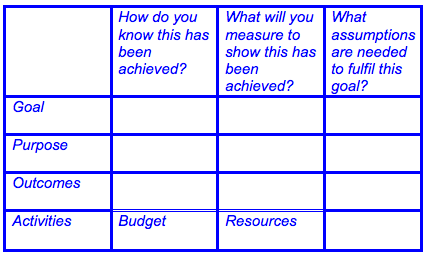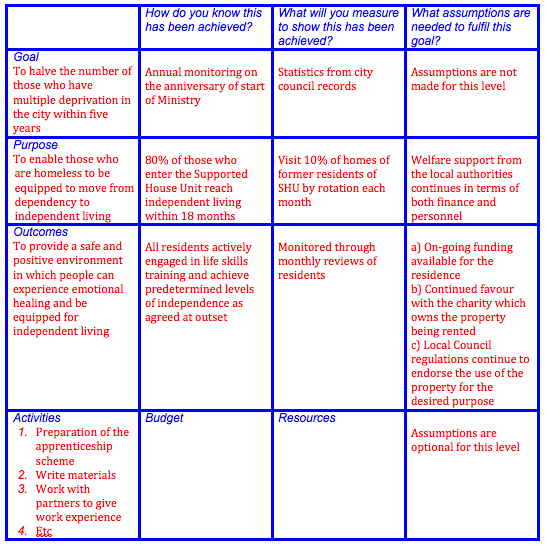
So far we have seen the importance of clearly defining goals at different levels and the associated assumptions we are making if they are to be achieved. These columns are the first and fourth columns in a 4×4 matrix.
To complete the matrix we must separate these two columns and insert two more. These additional columns allow us to specify how we shall monitor performance.
How and What?
When planning a ministry it is important to put in place ‘good practice’ for carrying it out. Frequently, good protocols are in place for handling such issues as client confidentiality, finances and so on. However, less attention may be given to how performance will be monitored. From time to time a qualitative assessment may be made but this is subject to distortion due to the desire to achieve success.
Be SMART
To avoid the pitfall of being over-optimistic it is helpful to decide in advance
a) what indicators will be used to measure success
b) how these measurements will be made or acquired
The goals’ column should be SMART i.e.
Specific
Measurable
Achievable
Realistic
Time related
The second and third columns are used for monitoring progress with these goals helping you to plan how to demonstrate these characteristics.
Looking at the example we have been using I will now suggest some simple Indicators and Measurements. In a real situation there would probably be more of each – the ones given are only for illustration.
Budget and Resources
The above completes the main components of the Logframe. However, since it is not necessary to have Indicators related to the activities (they monitor themselves – either you are doing them or not!) the two remaining cells in the matrix are often used for listing the Budget and Resources. These are a vital part of any grant application to a potential donor.
Resources are self-explanatory and include personnel, plant (buildings etc), equipment and expendable items such as medicines for a clinic. These will be identified through the planning process as you consider the activities in detail. They have a significant effect on the budget – indeed they probably represent the largest proportion.
Budgeting is a skill that is important to master which I shall deal with in a future series on Finance. In this context of planning a ministry it is most important to recognise that a budget is a ‘best guess’ about future expenditure. Once that is determined the need for income is defined. It must include both capital expenditure (such as equipment you will need to buy at the start of a ministry) and on-going expenditure (salaries, rents, administration costs etc). These must be clearly identified and separated. Typically the first year’s expenditure is higher than later years’ as this phase includes the purchase of capital items.
The Logframe is a powerful tool and much is available on the internet about different interpretations and methods of using it. However, this series has sought to provide a good ‘starter’ for those planning a new ministry with those who are Poor or Disadvantaged.


